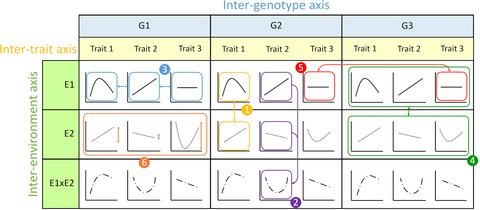当前位置:
X-MOL 学术
›
Funct. Ecol.
›
论文详情
Our official English website, www.x-mol.net, welcomes your
feedback! (Note: you will need to create a separate account there.)
A multidimensional approach to the expression of phenotypic plasticity
Functional Ecology ( IF 4.6 ) Pub Date : 2020-08-28 , DOI: 10.1111/1365-2435.13667 Thibaut Morel‐Journel 1 , Virginie Thuillier 1 , Frank Pennekamp 1, 2 , Estelle Laurent 1 , Delphine Legrand 1, 3 , Alexis S. Chaine 3, 4 , Nicolas Schtickzelle 1
中文翻译:

表型可塑性表达的多维方法
更新日期:2020-11-06
Functional Ecology ( IF 4.6 ) Pub Date : 2020-08-28 , DOI: 10.1111/1365-2435.13667 Thibaut Morel‐Journel 1 , Virginie Thuillier 1 , Frank Pennekamp 1, 2 , Estelle Laurent 1 , Delphine Legrand 1, 3 , Alexis S. Chaine 3, 4 , Nicolas Schtickzelle 1
Affiliation

|
- Phenotypic plasticity is increasingly recognized as a key element of eco‐evolutionary dynamics, but it remains challenging to assess because of its multidimensional nature. Indeed, organisms live in complex environments where numerous factors can impact the phenotypic expression of traits (inter‐environment axis), possess multiple traits that can influence each other's expression (inter‐trait axis) and differ in their genetic background (inter‐genotype axis), which can not only impact the traits' values but also their plasticity.
- We addressed six questions related to phenotypic plasticity: (a) do different environmental gradients show similar effects on a given trait? (b) Are the effects of two environmental gradients on a trait additive? (c) Do different traits show similar plastic response to a given environmental gradient? (d) Do the (co)variances between traits vary across environmental gradients? (e) Do genotypes differ in their plastic response to a given environmental gradient? (f) Are some genotypes more plastic than others across all traits?
- We designed a microcosm experiment using the protist Tetrahymena thermophila aimed at encompassing all these aspects of phenotypic plasticity. We exposed 15 distinct genotypes to 25 combinations of temperature and nutrient availability and assessed the plasticity of five phenotypic traits.
- Our results show strong differences in the plastic response depending on the environmental gradient, not only regarding the shape of the reaction norm of the different traits tested, but also in the overall plasticity of the organisms. We did not find any covariance between traits that was consistent across all environments.
- Overall, our results suggest independent impacts of the environmental dimension considered on the observed plastic response. These results underline potential difficulties in generalizing findings about plasticity to all environments and all traits.
中文翻译:

表型可塑性表达的多维方法
- 表型可塑性日益被认为是生态进化动力学的关键要素,但由于其多维性质,对其进行评估仍然具有挑战性。的确,生物体生活在复杂的环境中,其中许多因素会影响性状的表型表达(环境间轴),拥有多种会影响彼此表达的性状(性状轴),并且其遗传背景也不同(基因型轴) ),这不仅会影响性状的价值,而且会影响其可塑性。
- 我们解决了与表型可塑性有关的六个问题:(a)不同的环境梯度对给定性状是否表现出相似的影响?(b)两个环境梯度对性状添加剂的影响吗?(c)在给定的环境梯度下,不同的性状表现出相似的塑性反应吗?(d)性状之间的(协)方差是否随环境梯度而变化?(e)基因型对给定环境梯度的塑性响应是否不同?(f)在所有特征中,某些基因型是否比其他基因型更具塑性?
- 我们设计了一个利用原生性四膜虫嗜热菌的缩影实验,旨在涵盖表型可塑性的所有这些方面。我们将15种不同的基因型暴露于25种温度和养分利用率的组合中,并评估了5个表型性状的可塑性。
- 我们的结果表明,取决于环境梯度,可塑性响应之间存在很大差异,不仅涉及所测试的不同性状的反应规范的形状,而且还涉及生物的整体可塑性。我们没有发现在所有环境中都一致的性状之间的协方差。
- 总体而言,我们的结果表明,环境因素对观察到的塑性响应具有独立影响。这些结果突显了潜在的困难,难以概括关于所有环境和所有性状的可塑性的发现。











































 京公网安备 11010802027423号
京公网安备 11010802027423号